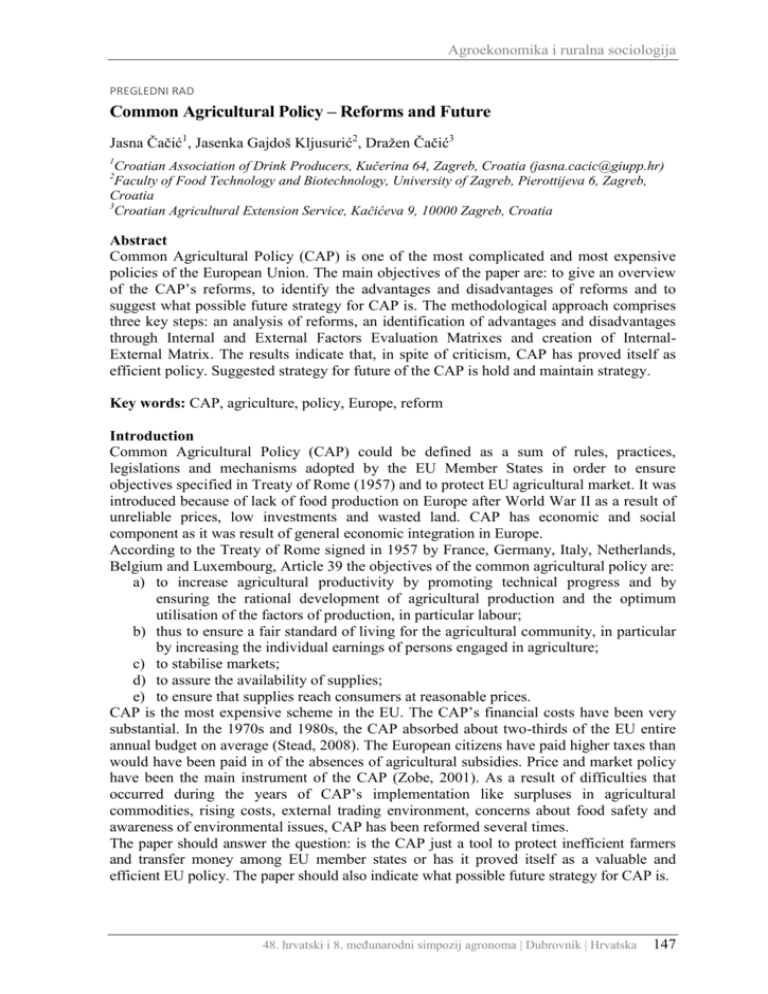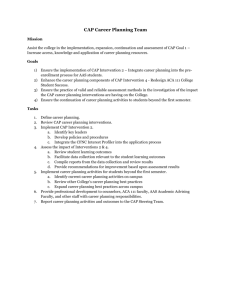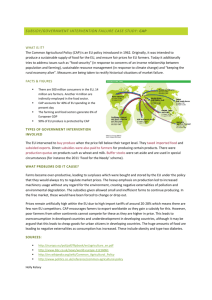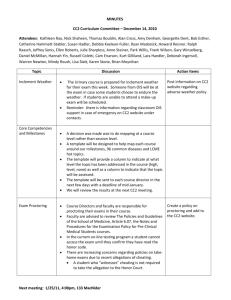
Agroekonomika i ruralna sociologija
PREGLEDNI RAD
Common Agricultural Policy – Reforms and Future
Jasna Čačić1, Jasenka Gajdoš Kljusurić2, Dražen Čačić3
Croatian Association of Drink Producers, Kučerina 64, Zagreb, Croatia (jasna.cacic@giupp.hr)
Faculty of Food Technology and Biotechnology, University of Zagreb, Pierottijeva 6, Zagreb,
Croatia
3
Croatian Agricultural Extension Service, Kačićeva 9, 10000 Zagreb, Croatia
1
2
Abstract
Common Agricultural Policy (CAP) is one of the most complicated and most expensive
policies of the European Union. The main objectives of the paper are: to give an overview
of the CAP’s reforms, to identify the advantages and disadvantages of reforms and to
suggest what possible future strategy for CAP is. The methodological approach comprises
three key steps: an analysis of reforms, an identification of advantages and disadvantages
through Internal and External Factors Evaluation Matrixes and creation of InternalExternal Matrix. The results indicate that, in spite of criticism, CAP has proved itself as
efficient policy. Suggested strategy for future of the CAP is hold and maintain strategy.
Key words: CAP, agriculture, policy, Europe, reform
Introduction
Common Agricultural Policy (CAP) could be defined as a sum of rules, practices,
legislations and mechanisms adopted by the EU Member States in order to ensure
objectives specified in Treaty of Rome (1957) and to protect EU agricultural market. It was
introduced because of lack of food production on Europe after World War II as a result of
unreliable prices, low investments and wasted land. CAP has economic and social
component as it was result of general economic integration in Europe.
According to the Treaty of Rome signed in 1957 by France, Germany, Italy, Netherlands,
Belgium and Luxembourg, Article 39 the objectives of the common agricultural policy are:
a) to increase agricultural productivity by promoting technical progress and by
ensuring the rational development of agricultural production and the optimum
utilisation of the factors of production, in particular labour;
b) thus to ensure a fair standard of living for the agricultural community, in particular
by increasing the individual earnings of persons engaged in agriculture;
c) to stabilise markets;
d) to assure the availability of supplies;
e) to ensure that supplies reach consumers at reasonable prices.
CAP is the most expensive scheme in the EU. The CAP’s financial costs have been very
substantial. In the 1970s and 1980s, the CAP absorbed about two-thirds of the EU entire
annual budget on average (Stead, 2008). The European citizens have paid higher taxes than
would have been paid in of the absences of agricultural subsidies. Price and market policy
have been the main instrument of the CAP (Zobe, 2001). As a result of difficulties that
occurred during the years of CAP’s implementation like surpluses in agricultural
commodities, rising costs, external trading environment, concerns about food safety and
awareness of environmental issues, CAP has been reformed several times.
The paper should answer the question: is the CAP just a tool to protect inefficient farmers
and transfer money among EU member states or has it proved itself as a valuable and
efficient EU policy. The paper should also indicate what possible future strategy for CAP is.
48. hrvatski i 8. međunarodni simpozij agronoma | Dubrovnik | Hrvatska
147
Agricultural Economics and Rural Sociology
Material and methods
The research is based on the quality analysis of CAP’s reforms. Besides, Internal Factors
Evaluation (IFE), External Factors Evaluation (EFE) and Internal-External (IE)
methods/matrixes are used in the paper. The matrixes are strategic management tools used
for conducting an internal and external audit of CAP and they provide a basis for
identifying and evaluating relationships among internal and external areas. Quality analysis
is used as a source for external and internal information needed for development of
matrixes. Although IFE and EFE methods could be understand as subjective ones,
introduction of numbers into formation of matrixes (assigning weights and ratings to
individual factors) give certain empirical component to model. Intuitive judgments and
understanding of factors included are required in developing the matrixes.
Results and discussions
The role of agriculture in the European Union is large. Although agricultural sector had not
contributed a lot to the GDP of Europe (between 14% in 1950s and 4% in 2003) its
importance within the entire economy is unquestionable. Speaking about historical
development of the CAP, productivity was key word at the beginning of the EU
agricultural policy as the main concern in Europe in the 1950s was to increase the food
supply (Fennell, 1997). The first reform after inception of CAP came in 1968 and is known
as Mansholt Plan. Main principles of the reform were: increasing competitiveness of
farmers and European food productions as well as introduction of rural development policy
for disadvantaged areas.
Growth in agricultural productivity and the stimulus of price supports have led to
overproduction in Western Europe (Tracy, 1984) so the next fundamental reform proposed
by the commission started in 1983 and continued till 1988. The changes were needed
because of over production, exploding expenditure in agriculture (around 70% of the
whole budget), environmental unsustainability and trade disputes. The main goals of the
reform were: balance on the market between supply and demand, food security, preserving
the nature landscape and the environment.
In 1992 MacSharry reform took place and it attempted in reducing agricultural prices on
major products (cereals, oilseeds, beef) making agriculture more competitive in the internal
and world market. The main objectives of this reform besides the reducing prices were:
compensations to the farmers by direct payments for reducing prices based on historical
yield and animal numbers and 10% set aside as an obligation. This reform was very
important for the CAP’s future setting the path for de-coupled model of farm support.
Since 1992 reform, competitiveness was key point of the CAP.
After that Agenda 2000 brought new way of thinking and sustainability as a primary
objective of the reform. It included: promotion of a fair standard of living for farmers,
creation of substitute jobs, introduction of new policy for rural development (second pillar)
and improvement of food safety and quality.
CAP reform in 2003 known as Fischler reform have introduced decoupling and single farm
payments, cross compliance with environmental program, modulation, strengthening of
rural development policy, simplification of CAP and WTO compatibility.
The reform in 2008 known as CAP Health Check brought new measures (phasing out milk
quotas, decoupling of support, shifting money from direct aid to rural development,
abolition of set-aside) in order to allow a better response to the new challenges and
opportunities faced by European agriculture. CAP represents now days nearly 40% of the
EU budget and remains a highly controversial policy despite past reforms (Swinnen and
Knops, 2012). According to the same authors, today budget for CAP remain largely
untargeted and inequalities in payment distribution persist. Taking into account all reforms
148 48th Croatian & 8th International Symposium on Agriculture | Dubrovnik | Croatia
Agroekonomika i ruralna sociologija
and changes of the CAP it could be concluded that the main beneficiaries are bigger
farmers (20% from all farmers) who receive 74% of funding. When speaking about the
member states, the most benefits have states with large agricultural sector like France
being largest recipient of CAP funds, followed by Spain and Portugal.
In order to analyse advantages and disadvantages of Common Agricultural Policy EFE –
IFE methods have been used. EFE matrix has been made taking into account external
factors that could influence Common Agriculture Policy. According to the Riston (2008)
external analysis include acting as an early warning system increasing awareness of
environmental changes.
Table 1. The External Factors Evaluation (EFE) Matrix
Description
Weight
OPPORTUNITIES
Self-sufficiency in food production
High standards of food safety and animal
welfare
Europe’s surpluses can food shortages in the
developing world
Keeping people on the land and in agricultural
business
Attract young people into farming
Maintaining the rich diversity of rural areas
Eliminating trade barriers within the
European countries – market without tariffs
THREATS
Spending too much money on subsidies
Fierce of competition from emerging giants
(China, India)
Not enough investments in agricultural
research
Artificially high food prices for EU
consumers
Aging population of European farmers
Using non-tariff barriers for import from nonEuropean countries
Rating
Weighted Score
0,12
4
0,48
0,04
2
0,08
0,09
3
0,27
0,10
0,08
0,05
2
1
1
0,20
0,08
0,05
0,12
2
0,24
0,13
4
0,52
0,08
3
0,24
0,05
2
0,10
0,03
0,05
1
2
0,03
0,10
0,06
3
0,18
1,00
2,57
IFE matrix for Common Agricultural Policy has been made based on strengths and
weaknesses that occur as a result of CAP’s reforms.
Table 2. The Internal Factors Evaluation (IFE) Matrix
Description
Weight
STRENGTHS
Keeping agricultural business sustainable
0,05
Guaranteeing food quality and safety
0,13
Encouraging environmental farming
0,02
Reducing reliance on imported food
0,15
High-level of protection for EU agriculture
0,18
Fair and stable income for farmers
0,04
Rating
Weighted Score
3
4
3
4
4
3
0,15
0,52
0,06
0,60
0,72
0,12
48. hrvatski i 8. međunarodni simpozij agronoma | Dubrovnik | Hrvatska
149
Agricultural Economics and Rural Sociology
WEAKNESSES
Low elasticity of demands
0,03
Differences in yields, input prices and
revenues between the regions of EU
0,05
Volatility of production
0,03
Growing expenditure for CAP
0,06
Surpluses in agricultural commodities
0,02
Comprehensive and oversize legislation
0,11
Complex decision making process
0,13
1,00
2
0,06
1
2
1
2
1
1
0,05
0,06
0,06
0,04
0,11
0,13
2,68
The results of the Internal and External Matrix were used for the Internal-External (IE)
Matrix in order to suggest the possible future strategy for Common Agricultural Policy.
Table 3. The Internal-External (IE) Matrix
The IFE total weighted scores
The
EFE
total
Strong
Average
weighted scored
3.0 to 4.0
2.0 to 2.99
High
3.0 to 4.0
Medium
EFE 2.57
2.0 to 2.99
IFE 2.68
Low
1.0 to 1.99
Weak
1.0 to 1.99
The IE Matrix is strategic management tools and in the paper is used to analyse working
conditions and strategic position of CAP. It is continuation of EFE and IFE matrix models.
Results from IE Matrix indicated that hold and maintain strategy (David, 2007) should be
suggested as future CAP strategy. The model of CAP should be defended and threats
should be ward off.
Conclusion
In spite of several attempts to reform the CAP through the history, problems in EU
agricultural sector still exist and have not been solved yet. That is not surprising taking into
account oversized legislation and complexity of decision making process between member
states. On the other side fair and stable income, keeping people on the land and attracting
young farmers to enter into agriculture are some of the most important positive impacts of
the CAP proving its efficacy.
According to the results of the IE Matrix, Europe should continue with its agricultural
policy in order to keep place achieved in the world market as a second largest global
exporter and the biggest importer and to protect themselves from competitors from other
markets. In sectors like agriculture where the competition is high because of technological
changes and more liberalisation, Europe needs to defend competitive position. Changes
should be made in order to maintain its competitive advantages. At this point CAP should
be oriented on new market segments to increase market share and to develop new products
or modify existing products. On the other hand, CAP should expand but not aggressively.
It could be concluded that in spite of lot criticism, Common Agricultural Policy has proved
itself as an efficient tool in defending European market.
Lessons learned from the CAP should be a road mark for Croatian policy and decision
makers. Those lessons should be taken into account by planning future of Croatian
agriculture.
150 48th Croatian & 8th International Symposium on Agriculture | Dubrovnik | Croatia
Agroekonomika i ruralna sociologija
References
David F.R. (2007). Strategic Management, Concept and Cases, Pearson Prentice Hall, Upper
Saddle River, New Jersey.
Fennell R. (1997). The Common Agricultural Policy - Continuity and Change, Clarendon press
1997, Oxford
Riston N. (2008). Strategic Management, Neil Riston and Ventus Publishing APS. -5
Stead D. R. (2008). The Birth of the CAP, EuroChoices, Vol (7)::6-12
Swinnen J.F.M., Knops L. (2012). CAP Reform: Will the European Parliament take the bull by
the horns, CEPS Commentary, Agricultural and Rural Policy, pages 5. Available at:
http://www.ceps.eu/book/cap-reform-will-european-parliament-take-bull-horns
Treaty of Rome (1957). Available at: http://ec.europa.eu/economy_finance/emu_history/
documents/treaties/rometreaty2.pdf
Tracy M. (1984). Issues of Agricultural Policy in a Historical Perspective, Journal of
Agricultural Economics, Vol (35): 307-318
Zobe H. (2001). The Economic and Historical Foundation of the Common Agricultural Policy
in Europe, Fourth European Historical Economics Society Conference, Oxford, September
2001.
48. hrvatski i 8. međunarodni simpozij agronoma | Dubrovnik | Hrvatska
151






